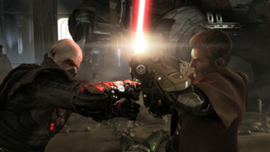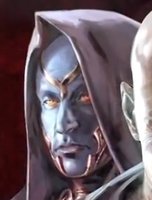Legends Galactic History 106: Wars of the Force
1. Introduction
This course covers events still being uncovered by historians during the middle of the Old Republic. As with previous courses, you will only be tested on material presented in this course. However, links to further reading are offered to give more information.
A quick out of character note: The video game Star Wars: The Old Republic has its storyline set in the midst of the events of this course, so there are spoilers contained within.
2. Great Galactic War (3,693 BBY - 2,000 BBY)
2.1 Revenge of the Sith
After the Great Hyperspace War, the Galactic Republic was ordered by its Supreme Chancellor to exterminate all remnants of the Sith. Though they were mostly successful, one Sith Lord - Vitiate - managed to gather the remnants and named himself Sith Emperor. Working from the shadows, this new Sith Emperor used puppets such as the Mandalorians (in the Mandalorian Wars) and Darths Revan and Malak (in the Jedi Civil Wars) to harass the Republic while rebuilding his Empire. The Imperial Navy had been in a constant state of training for hundreds of years and finally, in 3,681 BBY, the Emperor ordered his fleet to attack.

Their first strike was against the Sith tomb world of Korriban, which for centuries had been guarded by a small contingent of Jedi led by Jedi Master Kao Cen Darach and his Padawan Satele Shan, a descendent of Bastila Shan who fought in the Jedi Civil War. The Sith Lord Vindican and his apprentice, Malgus, led a fleet of thirty ships against the lightly guarded Republic contingent and annihilated them (killing Darach in the process). Another fleet appeared in the Tingel Arm and Aparo Sector, parts of the Outer Rim; the Republic attempted to negotiate with the Imperial warships, but their representatives were destroyed shortly after being allowed to broadcast an image of the Sith fleets back to the Republic.
While the Republic scrambled to mitigate this new threat, the Sith turned their sight elsewhere. Another Sith fleet attacked the completely undefended planet Sluis Van and destroyed the Republic’s orbital shipyard before conquering the world itself. The Sith attempted to either destroy or takeover the droid- and military-manufacturing planet of Balmorra. However, the natives rose against them and, with a strong Republic counter-attack, locked the Imperial forces on the planet into a drawn-out stalemate.
For a decade, the Sith ravaged the Outer Rim, taking over areas such as the Minos Cluster, the Seswanna sector, and planets such as Ilum and Manaan. It was estimated the Sith Empire controlled approximately 50% of the Outer Rim. They decided to move into the Mid Rim, thinking the Republic too busy rebuilding their forces to provide an adequate defense. On the planet of Bothawui, they discovered they were mistaken; their force was annihilated at the First Battle of Bothawui.
In retribution, Imperial commanders launched a massive counterattack. Republic forces, led by Jedi Master Belth Allusis, occupied extremely fortified positions and made the Empire pay dearly - approximately ten Imperials for each Republic soldier. The Second Battle of Bothawui ended with the death of every last Republic defender but forced Imperial forces to withdraw. Indeed, so strongly taken aback were the Imperials that the Sith Emperor was forced to halt further advancement and reevaluate his strategy.
Various battles were fought after Bothawui with victories for both sides. Eventually, the Sith decided they needed to bring in more firepower, and set out to recruit the Mandalorians as they had in wars past. Imperial Intelligence agents found a Mandalorian fighting as a gladiator on Geonosis and did everything in their power to ensure his rise as Mandalore the Lesser. With the Imperially-planted Mandalore in place, the Mandalorians blockaded the Hydian Way, one of the most important trade routes of the Republic.
This blockade was broken by a smuggler by the name of Hylo Visz who wanted to enrich herself considerably in the Republic’s time of need. The smuggler fleet, supported by Republic and Jedi ships, entrapped the Mandalorian fleet and destroyed it and the Imperial puppet Mandalore.
2.2 Treaty of Coruscant

Seven years after the Mandalorian’s defeat - a period of back and forth victories for both sides - the Sith Empire offered the Republic a parlay to discuss peace. The Jedi Council feared a trap and recommended against negotiations, but the Senate, weary of war, agreed. While the two sides met on Alderaan, the Jedi's fears were proven true as Darth Malgus led a group of Sith Warriors against Coruscant. They attacked the Jedi Temple, slaughtering all inside, while Darth Angral bombarded and invaded the planet, ultimately assassinating the Supreme Chancellor.
Essentially at gunpoint, the Republic negotiators were forced to agree to the Sith’s terms, and the Treaty of Coruscant was signed in 3,653 BBY, ceding control of huge portions of outlying systems to the Sith Empire. The Jedi Order was severely impacted, with hundreds dead, and the Republic chose to focus their anger and resentment on them. Though they continued to serve as protectors of the Republic, the Jedi returned to their homeworld of Tython to begin the long process of rebuilding.
The Sith Emperor decided to turn over day-to-day control of the Empire to his most trusted lieutenants, the Dark Council, and they oversaw a Cold War between the significantly increased and emboldened Sith Empire and weakened Galactic Republic. For years, proxy wars and puppets on each side would fight instead of their masters, and the Sith Empire circa 2,000 BBY had essentially disappeared. Greater scholarship into this troubled time is required to unlock its mysterious and lessons.
Further reading:
* Sacking of Coruscant
* Satele Shan
3. New Sith Wars (2,000 BBY - 1,000 BBY)

Sometime before 2,000 BBY, an Umbrian Jedi Master by the name of Phanius left the Jedi Order after disagreements over his studies of various Dark Side teachings. After falling to the Dark Side and becoming a Dark Lord of the Sith, he took the name Darth Ruin. During what became known as the Fourth Great Schism, fifty Jedi Knights left the order and pledged themselves to Darth Ruin and his newly reformed Sith Empire. He was not an inspiring leader - self-centered and single-minded - and his followers eventually turned on and murdered him.
However, his death was not the end of this latest version of the Sith. A shadowy figure known as the Dark Underlord led a vicious group known as the Black Knights to victory after bloody victory for 250 years until his death in 1,750 BBY. The war continued with devastating conflicts spanning across the Republic. The Jedi were forced into greater positions of leadership, despite the distrust many in the Republic felt toward them, assuming command of armies and serving as Supreme Chancellors; in fact, from 1,400 BBY to 1,000 BBY, there would not be a non-Jedi serving as the leader of the Republic.

By 1,100 BBY, both sides were in ruin. The Dark Lords of the Sith were too busy fighting each other and trying to consolidate their conquests to truly pose a threat to the Republic, but the Republic was on the verge of collapse itself - this period of time is known as the Dark Age of the Republic. Beginning in 1,010 BBY, the last major battles of the New Sith Wars would begin. A Jedi Master by the name of Skere Kaan had a falling out with the Jedi Council, despite their efforts to groom him as their champion, and he switched allegiance. He organized what he called the Brotherhood of Darkness, inviting all competing Sith warlords to join, and together they took over Korriban, Kashyyyk, and other worlds. The Republic reeled before eventually finding their savior - a Jedi Master named Lord Hoth. He reorganized the remaining Republic and Jedi forces into the Army of Light.

The Brotherhood of Darkness and Army of Light saw their final clashes on the planet Ruusan. The Army of Light won four of the seven battles fought on the planet, though both sides saw horrendous losses. Both were stretched to the breaking point, with defections and dissent rampant. During the Seventh Battle of Ruusan, Kaan, at the behest of his lieutenant Darth Bane, used an ancient Sith technique known as a thought bomb to destroy the Army of Light once and for all. Lord Hoth took ninety-nine of his most trusted Jedi to dissuade Kaan from using the ancient Sith superweapon, fearing its consequences. He was unsuccessful at convincing the insane Kaan, who triggered the weapon, wiping out all Sith forces and the majority of the Jedi.
Further reading:
* Thought bomb
* Jedi Lord
3.1 Ruusan Reformation

The Jedi regrouped under Valenthyne Farfalla, the senior-most surviving Jedi. Farfalla used this authority to remove the Jedi from leadership assumed across the Galaxy, including the Chancellorship, and installed the first non-Jedi in that position for six hundred years - Tarsus Valorum - who instituted a series of changes that became known as the Ruusan Reformation. The Jedi’s formidable military structure was disbanded, and the Order as a whole submitted itself to the Chancellor and Republic’s Judicial Department. Now, as an arm of the Republic’s judiciary, the Jedi Order was charged with keeping the peace and resolving disputes across the Galaxy. Though they would on occasion receive warning (mostly ignored), the Jedi and Republic thought the Sith extinct.
3.2 Rule of Two
Meanwhile, the Sith were undergoing their own reformation. Contrary to what the Jedi and Republic thought, the Sith had not all been wiped out with the thought bomb on Ruusan. Darth Bane, who had clashed with Kaan and provided him the instructions necessary for the weapon, had done so in order to destroy his rivals. He and his apprentice, a Force-sensitive child named Rain that he christened Darth Zannah, made their way to Onderon.
From there, he instituted the Rule of Two, which stated there would only be two Sith Lords - a Master and an Apprentice. The system, which he adopted from an ancient Sith holocron once belonging to Darth Revan, protected the Sith from the infighting that had plagued them and ensured the Apprentice could only rise and take power when strong enough to kill the Master. This continued, more or less uninterrupted, for almost a thousand years. The Sith - severely reduced in number by their own volition and thus less visible - set into motion a plot that would lead to the downfall of the Republic and the almost total eradication of the Jedi Order.
4. Conclusion
The Golden Age of the Republic - the last thousand years before the Battle of Yavin, was a period of relative stability, but as we know, this was merely the calm before the storm that would see the transformation of the Republic into the Galactic Empire. Now, it is time to test your understanding of this course. Good luck on your exam.
Please log in to take this course's exam